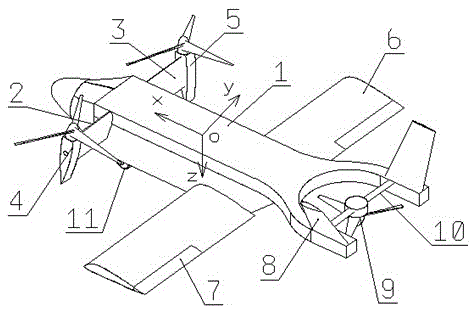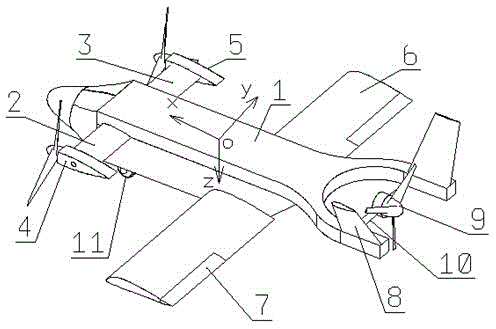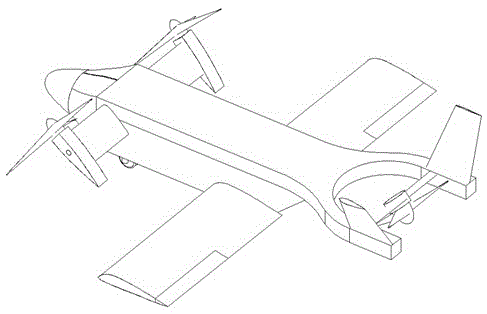Power-driven tilt three-rotor unmanned aerial vehicle
A technology of three-rotor and unmanned aerial vehicle, applied in the field of unmanned aerial vehicles, can solve the problems of small radius maneuvering and hovering, small payload, slow cruising speed, etc., and achieve the effect of improving flight efficiency and applicability
- Summary
- Abstract
- Description
- Claims
- Application Information
AI Technical Summary
Problems solved by technology
Method used
Image
Examples
Embodiment Construction
[0018] The specific embodiment of the present invention is described below in conjunction with accompanying drawing:
[0019] An electric tilting three-rotor drone, comprising a fuselage 1, a main wing 6, an aileron 7, a landing gear 11, a left canard 2, a right canard 3, a left motor rotor 4, a right motor rotor 5, a fixed V-shaped Empennage 8, rear motor rotor 9 and rear motor support rotating shaft 10, main wing 6 is installed in fuselage 1 middle part, landing gear 11 is arranged on fuselage 1 bottom, aileron 7 is arranged on main wing 6 rear outside, left canard 2 and right The canard 3 is connected to the fuselage 1 through rotary pumping, the left motor rotor 4 and the right motor rotor 5 are respectively fixed on the wingtips of the left canard 2 and the right canard 3, and the fixed V-shaped tail 8 is installed on the tail of the fuselage 1 Above, the rear motor rotor 9 is fixed and installed between the V-shaped tail 8 through the rear motor support shaft 10, the lef...
PUM
 Login to View More
Login to View More Abstract
Description
Claims
Application Information
 Login to View More
Login to View More - R&D
- Intellectual Property
- Life Sciences
- Materials
- Tech Scout
- Unparalleled Data Quality
- Higher Quality Content
- 60% Fewer Hallucinations
Browse by: Latest US Patents, China's latest patents, Technical Efficacy Thesaurus, Application Domain, Technology Topic, Popular Technical Reports.
© 2025 PatSnap. All rights reserved.Legal|Privacy policy|Modern Slavery Act Transparency Statement|Sitemap|About US| Contact US: help@patsnap.com



